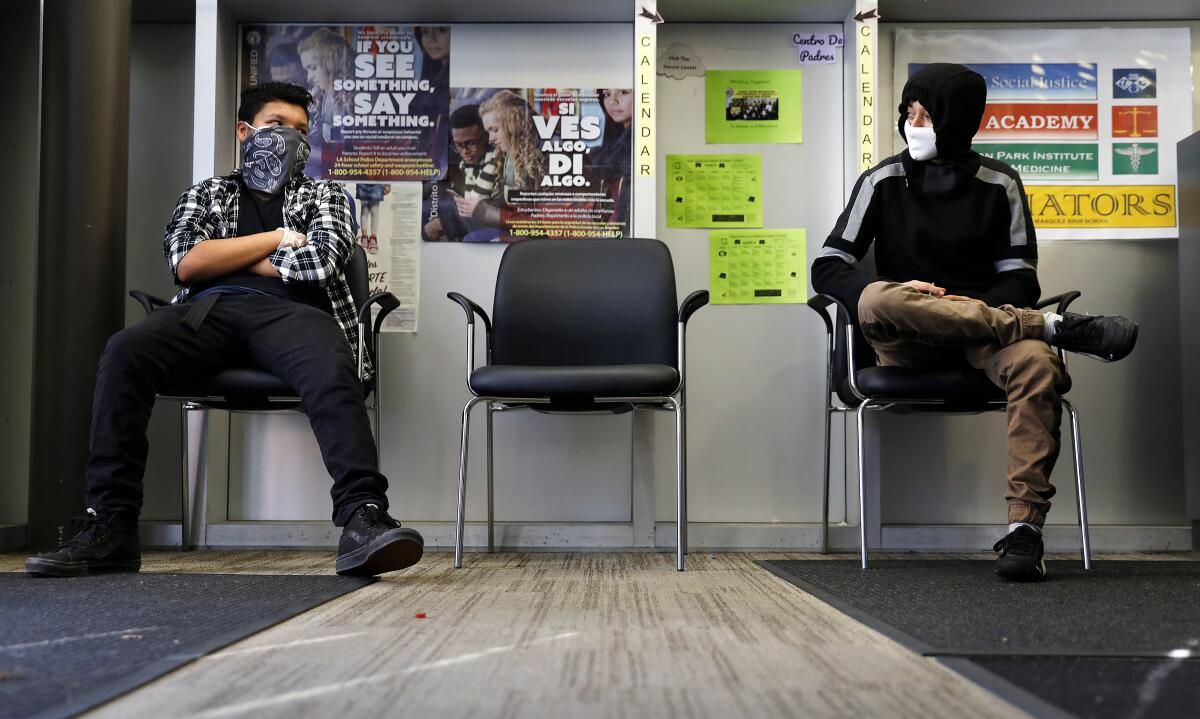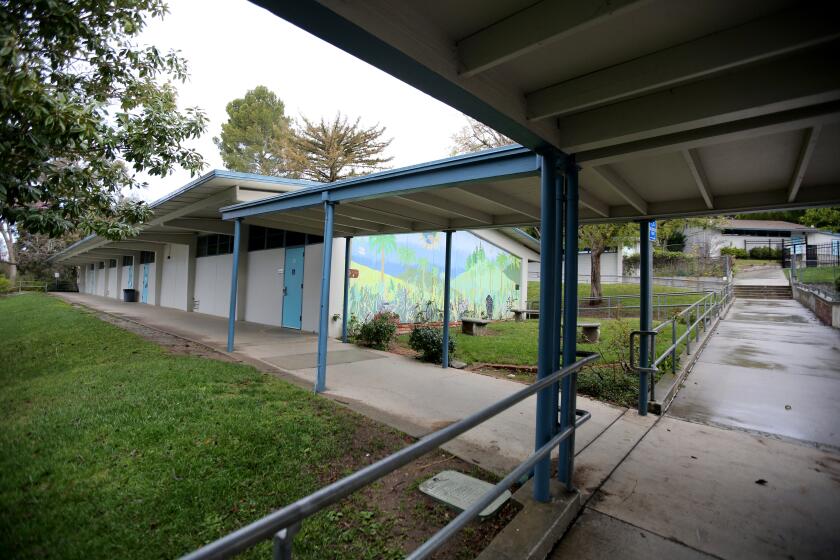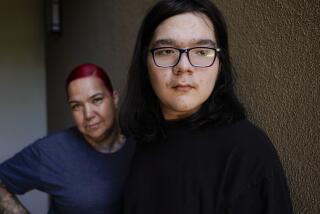15,000 L.A. high school students are AWOL online, 40,000 fail to check in daily amid coronavirus closures

- Share via
About 15,000 Los Angeles high school students are absent online and have failed to do any schoolwork while more than 40,000 have not been in daily contact with their teachers since March 16, when the coronavirus forced campus shutdowns, district officials disclosed Monday.
Those figures, the first official data on student online participation, reveal the massive challenge confronting the nation’s second-largest schools district, which is attempting an overnight transition to “distance learning” for half a million students, the vast majority from low-income families, many lacking computers and internet access.
Though it’s still early, the numbers demonstrate how the digital divide among underserved students as well many students’ lack of engagement and strong personal connection to their classes will likely contribute to a deepening and worrisome achievement gap, education experts said.
“This crisis has laid bare what we always knew — how equitable opportunities are so dependent on parental background and wealth and access to resources,” said UC Berkeley education and African American studies professor Janelle Scott. “Having a physical school does really matter and having caring adults around who can support children and family is vital.”
The L.A. Unified School District has moved quickly to distribute computers and has arranged for free internet access — moves that already may have helped thousands, but clearly have not replaced the classroom learning experience.
“It’s not like we went to virtual schooling because we thought virtual schooling was better,” Scott said. “We went to virtual schooling because it was a crisis.”
The 15,000 unaccounted-for students are an especially serious source of concern, said Supt. Austin Beutner, who released the figures Monday. The 40,000 who are not in daily contact with their teachers represents about a third of all Los Angeles high school students. However, some of them may be doing assigned work that does not require a daily check-in.
Officials declined to release similar figures for middle or elementary schools.
Let’s stop pretending that the kids stuck at home during the shutdown are getting ‘home-schooled.’ They’re not. California needs a plan.
“It’s simply not acceptable that we lose touch with 15,000 young adults or that many students aren’t getting the education they should be,” Beutner said in a video update. “This will take some time and a good bit of trial and error to get it right. And it will take the continued patience and commitment of all involved — students, families and teachers.”
Beutner says he hopes the online reach will improve as more families take advantage of the free computers and internet, arranged through a contract with Verizon. To get broadband, students will use individual hot spots — small digital cubes through which students can connect a computer to the internet.
“The great big digital divide many have spoken about is very real in the communities we serve,” he said. In response to what Beutner characterized as an urgent need, the superintendent used his emergency powers and authorized spending $100 million from district reserves for technology.
Many who remain disconnected “happen to be amongst our most vulnerable students,” he said. “It might be students in the foster system. It might be students who are experiencing homelessness. It might be students who were living in deep poverty. Those are students who struggle with attendance in ordinary times.
“The harder part is not the technology,” he said. “The harder part is establishing a connection to the student. And I don’t mean a digital connection. I mean that human connection of some sort.”
The staff at Thomas Starr King Middle School in Los Feliz is doing what it can, instructional technology coach Wil Page said.
But contact information for some families frequently becomes out of date — they move, they lose cellphone access, they change numbers, Page said. The current crisis has exacerbated such issues.
“We’re in such an extraordinary era right now that it becomes very difficult for some families to be able to make those outreaches and vice versa,” Page said.
Teachers at King are working in teams to figure out who’s missing, and then work on reaching out to those families, Page said. If they’re unsuccessful, the names are given to counselors and administrators.
“Distance learning may have great potential, but mostly it’s only worked well for high-achieving, self-motivated learners, and those with lots of family support at home,” said Michael J. Petrilli, president of the Thomas B. Fordham Institute, an education think tank in Washington, D.C.
Poor and working-class students, he said, “are least likely to have high-speed internet” and “were already learning well below grade level. We should expect many to struggle...That’s not to say that schools shouldn’t give it their all.”
Daniella Hernandez, a junior at Maywood Center for Enriched Studies, said half of the 30 students in Advanced Placement calculus have been attending online lessons. On Friday, however, there were only four students in the Zoom session.
“It can be a good thing sometimes because you get more of a one-to-one” experience, without the jokester in the back of the room disrupting class, said Daniella, 17. Yet, she also really misses those lighter moments. “It’s sad because those are the things that get you through,” she said.
Students in calculus already were familiar with online work because the instructor had been posting review materials before the shutdown. But the transition has been more difficult in other classes, where teachers sometimes “assign busywork instead of productive work... I just feel like sometimes it’s not getting me anywhere. I’m not learning as much as I should,” she said.
Although she is showing up virtually for fear of falling behind, she understands why some of her peers do not. “They’re not feeling inspired to get the work done,” she said.
Her classmate, junior Melissa Ponce, said that overall the school has done well — providing computers and hot spots — with teachers using multiple apps to keep students on track.
“I’m pretty sure there are students that just don’t want to log in,” said Melissa, 16. “Some students don’t want to be in school when we’re, like, in school.”
Teachers’ relationships with students before the closures could affect whether some show up, said UCLA education professor Tyrone Howard, who has been in contact with current L.A. teachers whom he mentored. The ones best able to take lessons online already had strong relationships with their students and their families.
Even so, some factors are simply out of the teachers’ control.
“Some kids will figure it was a time off, other kids don’t have the infrastructure, other kids are watching younger siblings, other kids are trying to find a job to help their family out,” Howard said.
It would be unfair to characterize students who have not yet connected as ditching or blowing off class, said UC Berkeley’s Scott.
“Certainly there are kids that are just disengaged from school...but a lot of it has to do with hunger, and housing insecurity,” as well as potentially a lack of an adult connection or health issues, she said.
More to Read
Sign up for Essential California
The most important California stories and recommendations in your inbox every morning.
You may occasionally receive promotional content from the Los Angeles Times.













